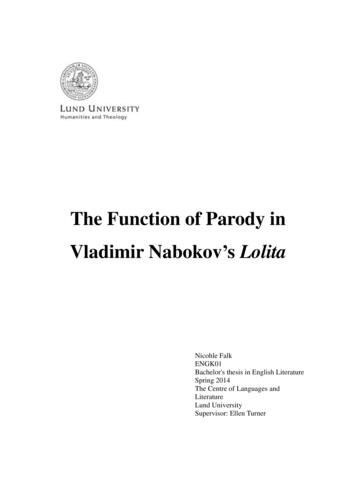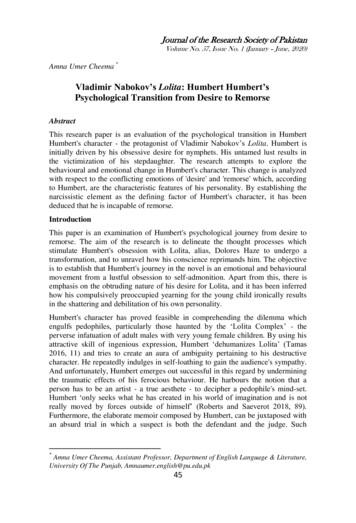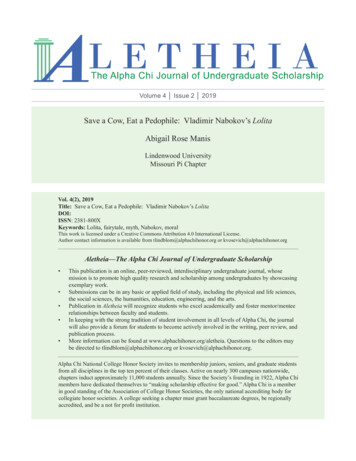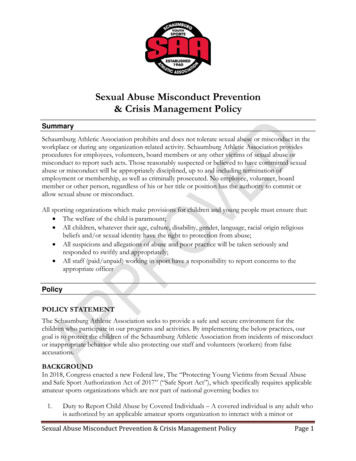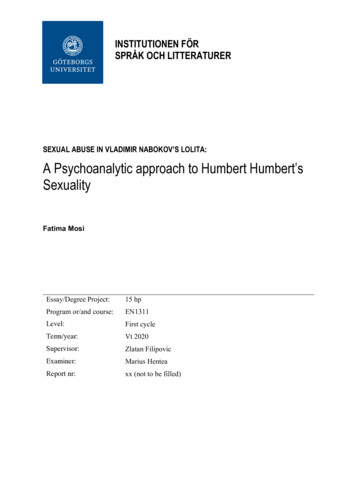
Transcription
INSTITUTIONEN FÖRSPRÅK OCH LITTERATURERSEXUAL ABUSE IN VLADIMIR NABOKOV’S LOLITA:A Psychoanalytic approach to Humbert Humbert’sSexualityFatima MosiEssay/Degree Project:15 hpProgram or/and course:EN1311Level:First cycleTerm/year:Vt 2020Supervisor:Zlatan FilipovicExaminer:Marius HenteaReport nr:xx (not to be filled)
AbstractTitle: Sexual Abuse in Vladimir Nabokov’s LolitaAuthor: Fatima MosiSupervisor: Zlatan FilipovicAbstract: Through examining Humbert Humbert’s psychological defense mechanisms inVladimir Nabokov’s Lolita, this essay aims to analyze Humbert Humbert’s sexuality throughthe framework of psychoanalytic theory by demonstrating how Humbert Humbert’s abuse isemployed as a psychological defense to process his sexuality. By analyzing his abusiveactions, the results suggest that the reason for Humbert Humbert’s psychological defense iscaused by his fear of abandonment that has been a constant issue throughout the novel, bothphysically and emotionally. This essay shows that the inconsistency of Humbert Humbert’sabusive behavior further indicates his denial and separation of self, contributing to hissexually abusive behavior.Keywords: Vladimir Nabokov, Lolita, Psychoanalysis, Sexuality, Sexual Abuse
Table of ContentsIntroduction . 1Methodology . 2Childhood . 5Incarnation . 10Justification . 12Imitation . 15Inconsistency. 17Conclusion . 20Bibliography . 22
IntroductionOriginating before medieval times, romantic fiction has since developed into what we nowknow and recognize as the romantic novel. However, the image of romance is frequentlydepicted as both sexist and violent, with endless portrayals of aggressive and possessive malelove interests. Furthermore, the depiction of sexual abuse in romantic literature is hardlyuncommon, particularly in young adult romance fiction such as the novel Twilight byStephanie Meyer, where the romantic gestures include abuse such as stalking and patronizingbehavior. Fifty Shades of Grey by E.L James has reached a wide demographic by introducingits readers to alternative sexual practices. However, the interpretation of BDSM in FiftyShades of Grey has gathered a wide variety of both recognition and controversy through hermisrepresentation of sexual abuse as a romanticized and erotic concept (pp. 69, 110).According to Bonomi, the depiction of abuse in literature normalizes the practice (2013).If sexual abuse has been the subject of numerous literary works, nowhere is it asuniquely portrayed as in Vladimir Nabokov’s Lolita. Published in 1955, Lolita has since beensubject to countless interpretations and has been described by readers as a romantic novel.Notably, the most common interpretations of the novel are perhaps best presented by DieterE. Zimmer’s online gallery of the numerous book cover designs of Lolita, depicting a youngvictim as a charming seductress. On the cover of the novel Lolita – the Story of a Cover Girl,Bertram and Leving write that these illustrations go against the will of the author, whoemphasized his objection towards “any kind of representation of a little girl” (p. 13). In linewith White, these cover illustrations continue to provide the world with a sexualized image ofa young victim (p. 38). The topic of this essay is the representation of sexuality, which hasbeen a major concern in the critical reading of this novel. However, the specific aim of thisessay will be to assess Humbert Humbert’s abusive actions in Lolita as a defense mechanismagainst his sexuality.Merskin states that the interpretation of “young girls as inviting and willingparticipants in their own sexual exploitation” are as interesting as they are disgusting (p. 97).Above all, the aestheticization of sexual abuse that occurs in the novel has resulted in theiconic sexualized image of young Lolita girls (Albright, p. 1). Albright finds that the iconicimage in question has featured female children in make-up and provocative poses in childbeauty pageants as well as advertising (p. 1). According to Albright, this image sends anegative message to young girls and women, conveying that they are nothing more thansexual objects (p. 1).1
Regarding Vladimir Nabokov’s Lolita, the novel is introduced as a statement bythe criminal, Humbert Humbert, and navigates the reader through a series of events that centeron his love and victim, Dolores Haze (1955). As the journey takes the reader on a kidnapper’sroad trip across America, navigating through the states by a series of sharp Freudian remarksand horrifying descriptions of sexual abuse, it delves into the psyche of a pedophile and hispassionate attraction to a growing child (1955). Incidentally, Assa states that Nabokov had anavid interest in psychology, as well as a passionate dislike for Sigmund Freud and his prototheories in psychology (p. 1). Despite the author’s aversion towards Freud, the content of thenovel is largely composed of Freudian themes. Still, the research aimed at sexuality, or sexualabuse, particularly in Lolita is typically approached through a feminist perspective and lacksother viewpoints.This paper aims to explore the depiction of Humbert Humbert’s sexual abuse asa psychological defense against his repressed sexuality through the framework ofpsychoanalytic theory. This will be accomplished by analyzing Humbert Humbert’sdelusional interpretations of romance and how it changes throughout the narrative.Furthermore, this paper will establish how his unconscious defense mechanism against hisabusive actions towards Dolores Haze is manifested to subjugate his guilt for abusing hisunderage lover. Additionally, it aims to identify Humbert Humbert’s sexual love towardsLolita as a psychological regression of his sexual love towards Annabel, which will act as oneof the fundamental issues of this study. By delving into the unconscious mind of HumbertHumbert, this research paper seeks to answer questions such as how Humbert’s actionsindicate psychological patterns of destructive behaviors and how sexuality and violence arerepresented through the portrayal of characters in Vladimir Nabokov’s novel Lolita.Addressing the claim through this approach highlights the concern of sexual abuse as an earlybehavior in a perspective that closely relates to the aim of this study.MethodologyIn agreement with Falk, Lolita can be interpreted as a parody of a variety of different genres,most significantly as a parody of Freud’s psychoanalysis (p. 1). As proclaimed by Werner,Nabokov’s aversion towards psychoanalysis, and Freud, is an indisputable fact and is provenby references to Freud that span half a century, as well as Nabokov’s interviews, letters,lectures, autobiography and the majority of his novels (p. 214). Humbert Humbert mirrorsNabokov’s hatred of psychoanalysis by enunciating his contempt for the discipline throughout2
the novel (p. 18). Despite the obvious mockery, a close reading of the novel Lolita will beconducted by approaching the concepts through psychoanalytic theory. By peeling back thelayers of obvious inserts of phallic imagery, the study seeks to access the analytic truth that ishidden underneath all the traps that were placed by Nabokov.To clarify, psychoanalytic theory is based on the principles that were establishedby psychologist Sigmund Freud (1856–1939). These principles are part of the mind’s defensemechanism and are used to protect the Freudian concept of “ego,” meaning the “I” or the“bearer of consciousness” against unacceptable impulses that cause anxiety (“A Glossary ofFreudian Terms”). As mentioned by Tyson, the defenses are the means through which theunconscious is kept repressed in the unconscious (p. 15). This is done to protect the mindfrom the information that the mind cannot handle knowing (p. 15). There are several types ofdefenses that protect the mind from information it cannot process at the time. However, thedefenses that will be included in this paper are denial, regression and projection. The meaningof denial is not believing in the existence of a problem, or perhaps even repressing theexistence of an event (p. 15). Regression can be described as a sort of flashback and is atemporary regression to a former psychological state that can either be pleasant or unpleasant(p. 15). Projection, on the other hand, includes assigning fears, issues, or guilty desire untosomeone else and condemning the other person as a substitute for oneself (p. 15).Additionally, other forms of defenses are included in the paper as defense mechanisms in linewith Sigmund Freud’s principles. Rationalization, for instance, is the ego defense whichincludes providing logical reasoning that justifies these impulses that lead to destructivebehavior (“American Psychological Association”). These defenses hide what are called thecore issues, such as fear of abandonment, fear of betrayal, etc., and are the main causes forfeeling anxiety (p. 16).According to Tyson, the concepts of psychoanalysis, such as defensemechanisms, are in such common use that people have acquired a simplified definition of theconcepts (p. 11). However, their superficial meaning poses a problem as it renders themmeaningless (p. 11). In other words, the disadvantage of the common use of psychoanalyticconcepts “in their clichéd form” is that people are unlikely to view them as means ofunderstanding human behavior (p. 11).However, as the fundamental concepts of psychoanalytic criticism is theunderstanding of human behavior, it is the ideal theory for the illustration of human behaviorin literary texts (p. 11). Furthermore, the main objective of psychoanalysis is to resolveunknown psychological problems, revealed through patterns of destructive behavior (p. 12).3
That notion is supported by the psychoanalytical concept of the unconscious (p. 12). Theunconscious is described as the container of unresolved conflicts, guilt, and other reasons fora person to experience anxiety or emotional pain (p. 12).Lolita is narrated from the perspective of Humbert Humbert and it is throughhim that the readers interpret the novel. Due to this, the psychoanalytic theory contributes tothe understanding of his unreliable narration, and, thereby, his unconscious mind, and whatmotivates his behavior. Thus, Lolita bases its structure on the interpretation of theunconscious mind behind the narration of Humbert Humbert.Psychoanalytic theory will be used in this paper by identifying the defense thatHumbert Humbert uses to contain the unconscious through the act of rationalization, as wellas denial, regression and projection (p. 15-16). These defense mechanisms are usedthroughout the novel and contribute to our understanding of Humbert Humbert as he formshis identity around his unconscious desires (p. 15).More importantly, the novel Lolita begins with the words of Dr. John Ray, Jr.,Ph.D. who explains that he has received a manuscript titled Lolita, or the Confession of aWhite Widowed Male from the deceased author, known as “Humbert Humbert, or H.H.’s,”lawyer. This manuscript, according to the doctor, depicts his horrible yet beautifully writtenmemoirs (pp. 1-3). The novel continues through the narration of Humbert Humbert’s happychildhood, where he met and lost his love, the twelve-year-old Annabel (pp. 8-14). This,according to the narrator, was the beginning of his attraction towards sexually desirablechildren he calls “nymphets” (p. 4). Throughout his adult life, he looks for children like hislost Annabel, until he finds Dolores, or as he calls her, Lolita (p. 14).His actions that are illustrated in the manuscript are described by Dr. John Ray,Jr. as persuasive, despite their horrible nature (pp. 1-3). This is the very essence ofrationalization, in how it normalizes actions that should otherwise be condemned. As we seein the case with Dr. John Ray, Jr., he is exposed to the rationalizations of Humbert Humbert,which affects his judgement of Humbert Humbert’s abusive actions towards Dolores Haze.This in turn, also influences the readers who process Humbert’s actions through therationalizing narration. In other words, although Humbert’s actions are horrible, they arerationalized to the point of actual reason. This impacts the reading of the novel as the reader isbeing manipulated by Humbert Humbert’s rationalization.This paper begins with Humbert’s early experiences and continues to analyze hispsychological patterns of destructive behaviors later on in life and will center on five sections.The first section will cover the childhood of Humbert Humbert through a psychoanalytic4
reading of his childhood days, along with his lost love. The second section, will include hisobsession of Lolita, whom he refers to as the incarnation of his lost love and how they bothconnect with each other (p. 14). The third section will, in turn, lead to the analysis of histendencies to justify his violent beh
Vladimir Nabokov’s Lolita, this essay aims to analyze Humbert Humbert’s sexuality through the framework of psychoanalytic theory by demonstrating how Humbert Humbert’s abuse is employed as a psychological defense to process his sexuality. By analyzing his abusive actions, the results suggest that the reason for Humbert Humbert’s psychological defense is caused by his fear of .Author: Fatima MosiPublish Year: 2020
